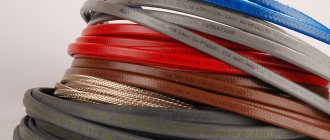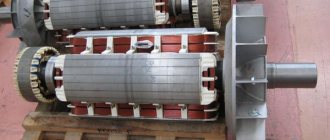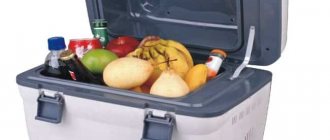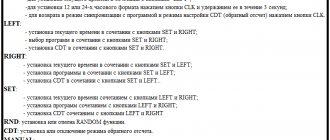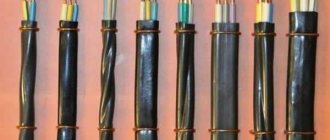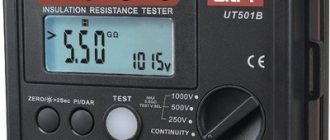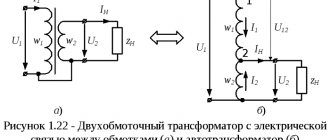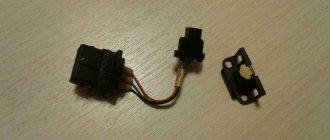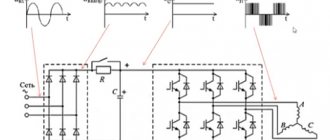What is a self-regulating cable?
In many areas, it is necessary to use cable products that respond to ambient temperature without the participation of additional sensors and regulators. A self-regulating cable is just such a device.
It independently changes the heating activity in different zones, taking into account current needs. The colder it is at the installation site, the more the conductor heats up.
To put it simply, this is a structure with two copper wires that conduct electricity, with a heating matrix located between them.
The latter is located throughout the range of the electrical circuit between the supply wires. The purpose of such a matrix is to heat and regulate, and there is a screen on the surface that protects the wire from the influence of the electromagnetic field.
There is another layer on top that guarantees resistance to mechanical damage.
Installation methods: why malfunctions occur
If it is necessary to lay it on flat surfaces, the cable is first unwound; if the work is carried out at low temperatures, then it is necessary to bring the wires into the room and wait until the cable becomes elastic.
Plastic clamps, ties, and brackets are used to secure them to the plane. In concrete products, you will have to pre-drill holes for subsequent tightening of anchors or installation of plastic dowels.
If during the laying process you have to connect fragments of the cord, then be sure to use heat-shrinkable sleeves (tubes). They are placed on the wire until the contacts are twisted, then they are pushed onto the exposed fragment and heated with a hair dryer or gas burner. This ensures complete tightness of the connection.
The thermostat is installed near the electrical panel, and a heating cable is connected to it. To ensure safety, an auto-shutoff device can be used, which is activated in the event of a short circuit or overheating.
If you need to provide heating for pipes, you should choose one of two options:
- Placing the cable outside.
- Laying the wire inside.
Installation when choosing the first method is easier, but there is a risk of damage to the cable during installation, and the heating efficiency of the liquid itself will be lower. To increase the temperature, you will have to wrap the pipe with insulation.
If installation is carried out on the surface, it should be taken into account that some pipeline elements are replaceable (taps, sensors, meters). In such places it is not recommended to lay the wire in a spiral; be sure to loosen the tension (make a loop) so that you do not have to cut the cord if you need to replace the plumbing element.
If the wire needs to be laid inside, it is important to choose the appropriate diameter of the cord, otherwise the water pressure will be significantly reduced. The main disadvantage of such installation is the complexity of the work, the need to use seals and special cords.
Installation of heating cable for the floor.
For installation in pipelines, it is necessary to use “food grade” cables. Their braid should consist of polyolefin, which does not emit harmful substances.
The cable stopped heating, possible reasons:
- The problem is caused by the cord itself. It is necessary to measure its resistance using an electrical tester (multimeter). The value must not be zero.
- The voltage in the house is below nominal. In this case, the cable will not work effectively.
- The automatic shut-off device has tripped or is faulty. Check the condition of the unit, if necessary, eliminate the short circuit.
- The contacts in the shield are oxidized and damaged. The connections should be restored by first cleaning them. To protect against oxidation, special varnishes are used.
Expert opinion
Torsunov Pavel Maksimovich
If the problem cannot be resolved, then the problem may be complex. It is necessary (if possible) to disassemble the electrical heating system and identify defects.
Classification and types of self-regulating cables
When choosing a self-regulating heating cable, it is important to consider the type on which the characteristics directly depend. There are several types of such products.
Self-regulating cable without shield
The peculiarity is the absence of an additional outer shell that protects against the influence of the electromagnetic field.
Thanks to this feature, the product loses in price and is more accessible to the buyer. Resistance to mechanical and natural influences is maintained, but protection from electrical damage is lower.
Due to the lack of shielding braid, installation in open areas and places where there is aggressive influence is prohibited.
Models without a screen are installed in areas where there are no UV rays and no risk of mechanical influence. The conductor may be damaged if it is tapped, walked on, beaten, etc. Sold as a cut or included as a set.
Shielded self-regulating cable
A special feature is the presence of a special screen that protects against EM radiation, increasing resistance to external influences. This is a more universal option, presented in several types depending on the scope of application.
Sold as a set, cut or resistive. At the time of sale, they may be classified as products for installation inside or on top of pipes and drains, for roofing, drains, etc.
General purpose self-regulating cable
A separate category includes products that have a general purpose and are not suitable for performing special tasks. There is no normal protection from UV rays or external influences.
For this reason, the products are usually used for heating different types of pipes and drains. Installation on roofs or gutters is prohibited, where there are negative factors that can reduce service life.
Additional classification
When choosing self-regulating cables, it is necessary to take into account their additional features.
They may have the following characteristics:
- explosion protection;
- for low voltage sources.
All products are cut or come in ready-made kits.
Features of the heating cable
The water supply cable is used to ensure that the water in the pipes remains in a liquid state even at subzero temperatures. In fact, it is a regular heating element that converts electrical energy into heat, taking into account the required temperature.
The design features that a heating cable for water supply must have are as follows:
- Multilayer , has several layers of insulation (according to GOST, at least 2).
- Increased flexibility . This allows installation of the cable on a pipeline of any configuration.
- Resistance to external influences and temperature changes.
- Immunity to aggressive conditions . Inside there should be a gasket in the form of a foil screen or copper braid. This avoids short circuits and neutralizes the magnetic field.
To choose the right heating cable, you should consider the main characteristics:
- Sufficient conductivity power for indoor installation per linear meter is 10 W/m.
- If the installation is carried out outdoors, then this figure should be increased to at least 20 W/m.
These nuances should be taken into account when choosing a wire in the same way as other indicators:
- Length . Not only the distance where the product will be laid is measured, but also the footage that will be required to insert the wires into the holes. A significant increase in length can lead to the fact that if the device is shorted or bent, the entire heating system will fail.
- Number of internal cores . Wires are produced in different thicknesses and have different conductor resistivities. The same diameter may differ in the internal filling, that is, in the number of cores.
Single-core and two-core cable Source sjevi.ru
- Section shape . Round – most often used for outer braiding. Flat - it is convenient to insert such a wire inside the pipe.
The maximum permissible temperature of the wire in the disconnected state should also be taken into account.
Scope of application
One of the main features of a self-regulating cable is its wide range of applications. It is suitable for heating eaves, water pipes, roofing and gutters, floors and other areas where water cannot be allowed to freeze.
Depending on the features, the following areas of application are distinguished:
- Private sector. It is used in water supply and sewerage facilities to prevent water from turning into ice and damaging pipes.
- Commercial structures. Use in city networks or in other organizations for heating pipes, arranging fire extinguishing systems.
- Industry. This category includes special heating cables that can operate in more severe conditions.
Manufacturers
The high demand for such products has led to the emergence of many companies engaged in the manufacture and sale of self-regulating cables.
Such products are manufactured in the USA, South Korea, Japan and a number of other countries.
Main manufacturers:
- South Korean company E&S Tec.Co.Ltd. They produce products for installation inside and outside pipes, for sewerage systems, gearboxes, gas pipelines, roofing, etc. Its self-regulating products are of high quality and have a service life of about 15 years. The products of this company are suitable for private and industrial heating.
- Heating Lux PSK is a Russian company engaged in the production of various types of heating cables. The finished products are characterized by a long service life, thoughtful design, and high quality of the materials used.
- Lavita is a large South Korean company with many branches in the Russian Federation and other countries. One of the activities is the production of self-regulating cable products. Finished products are fully certified, have a long service life and minimal energy consumption. They are used for heating containers and pipelines, and also as protection against ice formation.
- Raychem is a Belgian manufacturer that produces high-quality self-regulating cables with a service life of at least 40 years. They are economical, have no risk of overheating, are easy to mount and have a wide range of applications.
- Shtein is a well-known German manufacturer that produces products for protecting pipes from freezing. Heating cables are sold in coils and have a warranty period of 5 years or more. Depending on the design, they are used for external or internal installation. They have a shielding layer and additional protection on the surface. They are used in industry, construction and everyday life.
Other manufacturers of self-regulating cables have gained no less popularity. The category of popular ones includes the following companies - Aura, Devi, Rexant, Belamos, Extherm, Teplolux, Fine Korea, Heatline and others.
Areas of use
The heating cable is used to heat the following structural elements:
- heated floors – both in domestic (bathrooms and kitchens) and in industrial premises;
- roofs of buildings where there is a threat of icicle formation or accumulation of snow masses over sidewalks or pedestrian areas;
- various pipelines in water supply, sewerage, heating systems, etc.;
- containers and tanks for storing liquid substances;
- water disposal and drainage systems;
- heating steps of buildings, sidewalks and technological passages;
- heating mats, rugs and paths;
- aquariums and terrariums for pets.
In the industrial field, a heating cable can have more specific applications; examples of some of them and the necessary parameters for their effective operation are given in the table below:
Table: Application range of heating cable
| Application area | T required temperature, °C | Specific power, W/m2. | Total power, kW |
| Thermal barriers in industrial refrigerator chambers | 2-5 | 3 — 15 | 0,5-5 |
| Heating of satellite antennas | 2-5 | 200-300 | 2-15 |
| Heating of degreasing baths | 30-50 | 200-400 | 0,5-3 |
| Heated concrete production lines | 40-60 | 300 | 20-50 |
| Heating of press plates | 40-150 | 300-1000 | 2-10 |
Design features
Functional features and a wide range of applications are due to the thoughtful design of heating cable products.
The self-regulating cable consists of the following elements:
- A pair of copper veins. They run along the entire length and play the role of a current conductor.
- Heating matrix. This is the main element of the product, providing a change in the heating level depending on the ambient temperature. The element is located parallel between the wires, providing regulation and change in temperature conditions.
- Insulating layer. To increase the level of thermal protection, several layers of insulation are used.
- Shielding braid. It is made of metal and provides protection against EM and mechanical influences. This element of the cable product is grounded, providing additional protection against damage by electric current.
- Outer shell. Mandatory coating that protects the self-regulating cable from various types of damage.
Thanks to this design, the self-regulating cable is resistant to various types of damage and can serve for many years without the need for maintenance.
But we note that the composition of the heating conductor may vary depending on the purpose (with or without braided shielding). The characteristics of the protective shells and the diameter of the conductive cores also differ.
Operating principle
After studying the design features, a question arises about the principle of operation of self-regulating heating cables. It works on the principle of a conductor in an electrical network.
Heating leads to an increase in resistance, and the higher this parameter, the less current. As a result, wasted power is reduced and electricity costs are reduced.
If a section of cable passes over a cold section, the resistance decreases and higher current flows through the embedded matrix. This leads to heat generation and frost protection.
As the temperature rises, the current flowing through the mentioned node also increases. In other words, when the self-regulating conductor is turned on in the cold, it operates at maximum power, but as the nearby area heats up, this parameter gradually decreases.
The heating cable operates continuously and does not turn off when the temperature drops. All that changes is the heating level of the product.
On average, the power parameter of such a product is 10-20 W per 1 meter of length. But there are also products that consume up to 150 W. This is a low parameter that you can afford in the winter to avoid even greater expenses.
It is worth remembering that the resource is limited, so when heat sets in, the self-regulating conductor can be turned off.
Shutdown can be done manually or using automation (relays, thermostats). Such devices monitor temperature changes and supply voltage when the temperature drops.
But the installation of such equipment is not necessary, because the cable itself controls the heating level and when the temperature rises, it switches to the mode of minimum energy consumption.
Purpose and principle of operation
The purpose of heating cables allows them to cover both various areas of industrial activity and solve various household problems. The most common heating cables are used for:
- Heating of rooms or structures with small cubic capacity, including decorative rooms, terrariums, mines and wells;
- Heating the entire or just a section of a pipeline, water supply, sewerage and other objects located in the open air or in an unheated room;
- Warming up frozen objects when performing any technological operations on them;
- Protection against water freezing or to prevent moisture accumulation;
- Preventing ice formation or snow deposition;
- Maintaining the temperature of an object within specified limits.
The operating principle of a heating cable is described by the Joule-Lenz law, which states that when an electric current flows through any resistive element, thermal energy will be released from it. This process is caused by the presence of electrical resistance in the conductive material, which arises due to the interaction of charged particles. These particles create an obstacle to the directional movement of current, and when they collide, heat is released.
Based on the above, we can say that the amount of thermal power is directly proportional to the resistance of the heating cable and can be expressed by the formula:
Q = I2 * R * t
Where:
- Q – the amount of released thermal energy;
- I – the amount of current flowing through the heating cable;
- R – ohmic resistance of the element;
- t – time of connecting the cable to the electrical network.
In practice, the resistance of a particular heating cable will depend on the material of the current-carrying conductors, their length and connection method. All these parameters are determined by the design features of various types of heating cable products.
What is the difference from resistive cable
The main feature of a self-regulating heating product is the ability to change the temperature depending on the environment. Resistive models cannot do this and operate in one mode.
Against this background, we can highlight a number of features of self-regulating heating cables that allow you to make a choice in their favor:
- Economical. Unlike resistive “brothers,” self-regulating cables change power depending on temperature conditions. At the same time, you can save money on the purchase of thermostats, sensors and other control elements. It is enough to simply connect the product to the network for it to complete the task. Despite the higher cost, in the long run, a self-regulating cable pays for itself faster.
- Safety of use. Using resistive cable carries the risk of overheating some areas that do not require increased temperature. As a result, the entire system may fail. A self-regulating cable is more flexible because its temperature varies in different areas depending on environmental conditions. In an area with a higher temperature, the heating level is reduced, which helps protect the area from possible overheating.
- Reliable protection. A prolonged increase in voltage can lead to failure of the resistive cable. Self-regulating products are not afraid of such risks.
Other differences from the resistive version also stand out - improved strength characteristics, the possibility of overlapping wires in different areas and ease of length adjustment.
In comparison, resistive cables are typically sold in fixed lengths with no option for shortening. This parameter is limited to 150 m, which must be taken into account during the installation process.
Design and characteristics of the KDBS cable
The heating cable section KDBS is a heat-generating element based on a resistive heating cable in a protective PVC sheath. On one side it is equipped with an end coupling, and on the other - with a connecting coupling, installation wire and lugs for connecting to power. Any connecting wire is suitable for connecting to the network, for example, APV (aluminum conductors).
Technical characteristics of CBDS:
Example of heating section designation:
The nominal parameters of KDBS heating sections of fixed length and power are presented in the table:
Criterias of choice
When purchasing a self-regulating heating cable, there are a number of criteria to consider.
Let's highlight the main ones:
- Price. Depending on the manufacturer and design features, the price of such products also varies in a wide range - from six dollars per meter and above.
- Manufacturer. It was noted above that companies from many countries are engaged in the manufacture of such products - Russia, Denmark, South Korea, China, Germany and others. The range of products is wide enough to make a choice.
- View. On sale you can find cable products complete and with the possibility of cutting. Screened and non-screened versions are also available.
- Installation. When choosing, take into account the installation location - outside or inside the pipe. There are also universal models that allow installation anywhere (without special requirements).
- Scope of application. As a rule, self-regulating conductors are used for heating pipes, open areas, areas under screed or under tiles. But the scope of its application is not limited there.
- Power. The parameter varies over a wide range depending on the application. The power range is between 15 and 13,500 W.
- Voltage. Mostly self-regulating products are available for sale, designed for a voltage of 220 V. In rare cases, cables for 380 V are produced.
- Length. Unlike resistive versions, self-regulating models can be cut off. In this case, the length can be from one meter or more.
- Heat transfer regulation. Some models provide adjustment of the heat output level. Its presence leads to a general increase in price, which must be taken into account when purchasing.
- A fork is included. There are several options here - euro, Schuko or no plug.
Taking into account the above criteria, you can quickly select a self-regulating cable for the given parameters, requirements and scope of application. However, keep in mind that prices vary widely depending on characteristics, type, manufacturer and other factors.
Nuances of installation work
When the wire is securely fastened inside or outside, it is important to take care of the insulation of the end of the conductor. Experts recommend using heat shrink tubing. This product will perfectly protect the conductors from moisture, which will reduce the risk of short circuits and repair work. We must not forget that the heating part must be connected to the “cold” part.
Connecting wires Source termodar-64.ru
Tips and recommendations from experienced craftsmen:
- If you use two methods of laying wires inside and outside the pipe at once, you can increase the rate of water heating several times, but this will require additional installation costs.
- Heating water pipes with a self-regulating heating cable will allow you to ignore warm sections and direct the current to cold places. It is allowed to be cut, so there will be no problems in installation even in hard-to-reach places. The cable length does not affect heat transfer.
- Resistive wire is half the price, but its service life is much shorter. If a regular two-core cable was installed, you should prepare for the fact that in 5-6 years it will have to be replaced.
- The braid on the wire serves to ground it. You can skip this stage of work, but it is better to become familiar with grounding methods.
Advantages and disadvantages
A self-regulating cable is not an ideal product, because it has not only advantages, but also weaknesses.
Advantages:
- Reliability and simplicity of design.
- Uniformity and homogeneity of heating along the entire length with the ability to change the temperature regime in cold/warm areas.
- Resistance to sudden changes in voltage, lack of fear of sudden jumps in this parameter.
- Saving electricity. Even when operating at maximum power, electricity costs will be relatively small.
- Safety. The presence of several protective layers reliably protects against electrical damage. In addition, such products are not afraid of overlap and are reliably protected from overheating.
- There is no need for additional maintenance and costs.
- There are no length restrictions, which allows you to choose a solution for specific situations.
Self-regulating heating conductors also have a number of disadvantages:
- Higher price per meter of product.
- The cable is supplied in large quantities and often without factory couplings and glands for connection. There are also no connecting tubes that you need to connect yourself.
The main disadvantage for many buyers is the cost, but during long-term use the self-regulating conductor is more economical than its competitors. This is achieved thanks to the ability to change power depending on operating conditions.
Types of heating wires and cables
Most often, PNSV wires are used for electrical heating of concrete (heating wire with a steel core and PVC insulation). The popularity of this material is explained by its relatively low price and easy installation.
PNSV wire
PNSP can be used instead of PNSV. This wire features polypropylene insulation, which provides a slight increase in maximum heat output.
| Wire brand Parameters | PNSV | PNSP | ||||||
| Nominal value of electrical resistance of 1 m of heating core, Ohm | 0,12 | 0,18 | 0,22 | 0,11 | 0,12 | 0,14 | 0,18 | 0,22 |
| Conductor design | 1x1.2 | 1x1.1 | 1x1.0 | 1x1.4 | 1x1.2 | 1x1.3 | 1x1.1 | 1x1.0 |
| Nominal outer diameter, mm | 2,8 | 2,7 | 2,6 | 2,8 | 2,6 | 2,7 | 2,5 | 2,4 |
| Recommended wire length at voltage 220V, m | 110 | 95 | 80 | 130 | 100 | 110 | 85 | 75 |
| Estimated weight of 1 km of wire, kg | 19 | 18,5 | 18 | 16,4 | 12,7 | 14,5 | 11,1 | 9,6 |
Table of main parameters of PNSV and PNSP
Such wires are also used as floor heaters, which operate on the principle of a warm floor. When using thermal wires of this type, it is necessary to calculate their length. A small error can be corrected by adjusting the voltage level supplied from the transformer to heat the concrete.
The use of PNSV is effective, but is complicated by the need to install additional equipment to adjust the thermal power by changing the voltage. It is much easier to work with sectional thermal cables KDBS. They are directly connected to a 220V network, so they do not require any equipment to operate. You can buy such a heating cable in our stores in Moscow and the Moscow region.
Popular models offered by the market: overview of options
The market offers a large selection of self-regulating heating cables from different manufacturers. They differ in design features, cost and other parameters. Let's highlight several popular options.
BSX cable from Thermon manufacturer
This is a standard budget cable consisting of copper bars with a diameter of 1.3 square meters. mm, semiconducting matrix, insulation for heating by radiation, special copper braiding and polyolephrine sheath.
An anti-corrosion fluoropolymer shell is also provided on the surface.
There are four types of cable on sale, which differ in power density.
Buyers have at their disposal conductors for 9, 15, 25 and 32 W/m. Each of the four ratings has two insulation options - fluoropolymer or polyolefin.
The first option costs a higher price, but is more resistant to corrosion and negative chemical influences.
Elektra SelfTec DW
This is a self-regulating heating conductor designed for installation inside a pipe. It is distinguished by a reliable outer layer of insulation made of food-grade polyethylene, which allows the cable to be used in pipes where drinking water passes.
